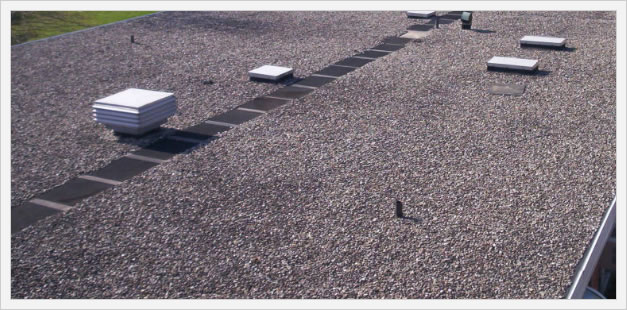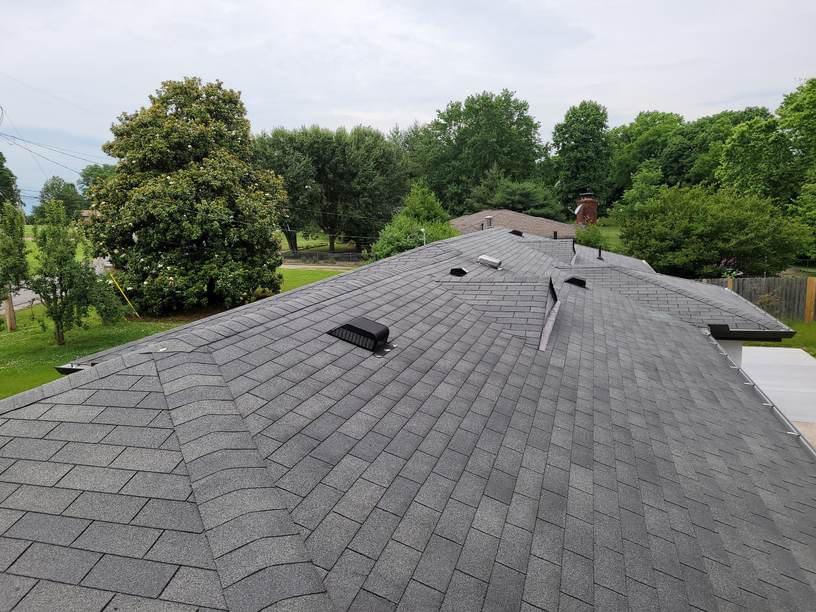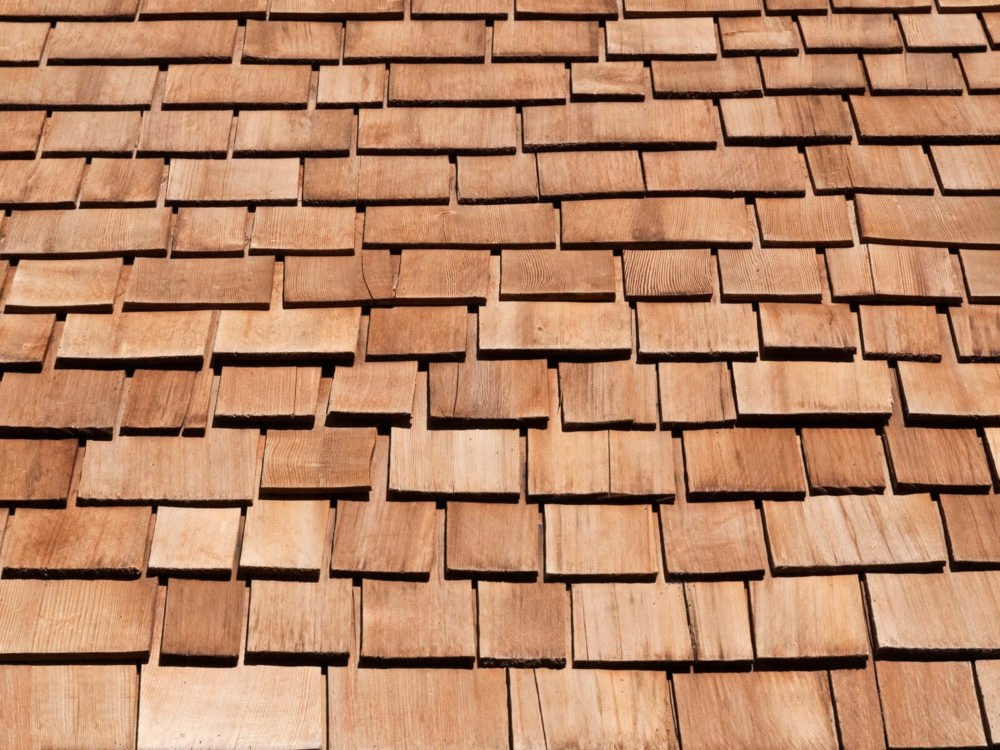
Roofing For Your Home
When selecting types of roofing materials for your home, there are plenty of choices available. Asphalt shingles, metal and concrete tiles are some of the most popular roof styles used on homes today. Asphalt shingles, wood, metal, membrane, and concrete tiles are some of the most popular roof styles used on homes today. Each has its advantages and drawbacks. So, to make sure you select the one best suited to your requirements Pro Home Construction have written the below in-depth guide.

Tar and Gravel Types of Roofing
Tar and gravel types of roofing are one of the most widely used flat roofing systems, suitable for both residential and commercial properties due to their durability, affordability, and longevity. Tar and gravel roofs offer numerous benefits that make them a preferred choice among property owners.
Tar and gravel roofing systems can be relatively straightforward to install if you hire an experienced roofer with expertise. However, this option may not be ideal for all buildings.
This type of roofing can be heavy. On average, they add five to 10 pounds per square foot of weight per foot of building structure; this may be too much for some structures to bear. This extra strain puts undue strain on both the underlying roof and substrate as well as strain on the entire facility.
Another issue with tar and gravel roofs is their propensity for ponding. This can create issues with drainage systems, as water can accumulate and cause leaks – especially if the roof is situated in an area which receives heavy amounts of rain or snowfall.
Additionally, tar and gravel roofs may be difficult to detect leaks due to the fact that you cannot see beneath the gravel where the tar layer lies. Finding out where a leak originates can be especially tricky in such circumstances.
Tar and gravel roofs tend to be more costly than other options, such as polyurethane foam or membrane roofs, so you should factor this into your decision-making process.
The lifespan of a tar and gravel roof depends on several factors, including how often it is maintained. On average, these roofs last 20 to 30 years before beginning to show signs of wear and need for repair or replacement.

Asphalt Shingles
Asphalt shingles have long been a go-to roofing material due to their affordability, ease of installation and resistance to weathering. Furthermore, these low maintenance materials require little or no upkeep throughout their lifespan.
Shingles are composed of asphalt, which can either be found as an oil refining byproduct or naturally occurring substance. Once exposed to air, this thick hydrocarbon material becomes oxidized or “blown,” to a specified viscosity. A fine mineral powder is then mixed into this blown asphalt for further fire resistance as well as increased durability and weathering properties.
Asphalt shingles begin with either organic fibers such as cellulose or inorganic materials like fiberglass. A saturated asphalt layer is applied to both sides of this mat, acting as a protective covering for its underlying surface. Finally, ceramic-coated opaque mineral granules are applied to form the ‘face’ of the shingle.
These granules give shingles their vibrant colors and protect from UV rays of the sun. Some even contain algae-resistant granules to prevent discoloration caused by blue-green algae growth. Finally, these granules are fired into different colors for lasting decoration on exposed areas of a shingle’s face.
Asphalt shingles come in a range of styles to mimic other roofing materials like wood shakes or slate, or to have special features like enhanced hail resistance and cool roof colors which reflect heat and reduce air conditioning costs.
Another popular type of shingle is dimensional (or laminate) shingles. These typically rectangular-shaped shingles come in various sizes and patterns; the most popular being three-tab style. There are also architectural shingles that mimic wood shakes for a rustic aesthetic.
Slate Types of Roofing
Slate is an easily fractured rock that can be cut into thin sheets for roof coverings and other structures. Due to its medium hardness level between brittle and tough, slate makes an ideal roof material.
Slate mineral composition varies, but some elements remain consistent: hematite, chlorite and carbon.
These minerals give slate its distinctive colors. Hematite adds purple highlights, chlorite creates green, and carbon creates distinctive blacks and grays.
Slate can be mined around the world, including Europe, India, Asia and America. The most prolific slate-producing areas are Vermont, New York (Slate Valley), Pennsylvania and Virginia.
Stone is mined manually from quarries. Large slabs are sawn off to remove them from the quarry and transport them to factories where they will be transformed into roofing tiles.
Slate roofs are an excellent way to protect your home and add value to your property. Furthermore, they require less upkeep than other roofing materials, meaning you’ll have a beautiful, long-lasting roof for years to come.
Slate shingles are often combined with other roofing materials, like asphalt or wood, for a classic aesthetic and to help it blend in with the rest of your home’s exterior.
Slate shingles, made from natural stones, provide a stunning and unique aesthetic to set your house apart from others. Not only that, but these durable roof coverings can last for generations if properly installed by an experienced roofing contractor.
Metal Types of Roofing
Metal roofing is an adaptable roof material that can be used on residential, commercial and industrial buildings. Metal roofs come in a range of materials such as aluminum, copper, steel, zinc and tin which all make great roof coverings.
They come in an array of colors and can be painted with paint systems that help reduce chalking, fading and chipping. Furthermore, there is a choice of styles to suit any building style.
Metal roofing is often seen on industrial and commercial buildings, but it can also be applied to homes, barns and other agricultural structures.
Homeowners often opt for metal roof installation due to its long life, energy efficiency and durability. Furthermore, metal roofing requires very little upkeep and only requires occasional cleaning.
Residential metal shingles are often coated with a durable paint system to minimize chalking, fading and chipping. Most paint systems come with warranties which guarantee that colorfastness for years to come.
Metal shingles may not be the cheapest option available, but they do last longer than asphalt shingles and will save you money in the long run with their energy savings. Furthermore, these durable shingles can withstand extreme temperatures, hurricanes and hailstorms with ease.
Metal shingles are lightweight and strong, as well as being less weight than traditional shingles. This allows them to be tailored down easily for architectural specifications without sacrificing strength or durability.

Eco-Friendly Types of Roofing
Wood is an abundant and renewable material, used in many applications such as housing, construction, furniture, utensils and other everyday items.
Trees contain a fibrous structure called wood, composed of cellulose fibers and lignin. Together these substances play an essential role in the growth and development of trees and other woody plants by providing support as well as transporting essential nutrients and water between cells and tissues.
When it comes to roofing materials, wood can be an appealing option. The primary advantages of using wood include its durability, ease of upkeep and environmental friendliness.
One disadvantage of wood for your roof is that it can deteriorate and rot if not properly maintained. This occurs due to exposure to sunlight, chemicals present in the wood, and other environmental elements. However, you can partially mitigate these effects with regular upkeep.
For example, you can use a wood preservative such as copper naphthenate to protect your wooden roof. This prevents the process of deterioration and maintains the color and texture of your wood.
Another benefit of wood is its variety of colors, enabling you to match the roof color to your home’s design and architecture. This can be especially helpful if you want your house to appear more aesthetically pleasing or have an unusually large house which needs to stand out in its neighborhood.
Different wood shingles come with their own distinct characteristics. Oak, for instance, is a popular choice for shakes and shingles due to its hardiness and longevity in the outdoors elements.
Other types of wood include teak, cedar and cypress. These materials can be stained and painted for an eye-catching aesthetic in your home.
Manufacturers sometimes provide pre-finished and bare-sawn wood shingles to make choosing your color easier. This can be an attractive alternative to traditional wood shingles, giving you the freedom to add a stylish new style without needing to hire an expensive professional roofer.
Cedar Shake Roof
Cedar shakes are a popular roofing choice for many homeowners, particularly those seeking an organic aesthetic that adds to their home’s curb appeal. Not only do they last longer than shingles but they work better on steep roofs too, giving homeowners the most out of their investment in a new roof.
Cedar shakes may be more costly, but they can be an excellent way to spruce up the exterior of your home. Not only will they give it a unique and eye-catching aesthetic, but they may even increase its resale value in the future.
Cedar shakes, as organic materials, require regular upkeep to keep them looking their best. This includes applying treatments that protect the wood from moisture damage, UV rays and seasonal changes.
With proper treatment, your cedar roof can last for 60 years or even longer! However, like any organic material it is susceptible to weather damage from elements.
That is why performing a visual inspection of your shake roof at least once annually is essential. Doing this allows you to detect damage before it becomes too late and requires costly repairs or even complete roof replacement.
As part of your inspection, look for splits or cracks in the wood shingles. If you discover these, contact a professional for repair or replacement.
Additionally, inspect the bottom edge of your shakes for signs of moss or rot. Take action now before these issues lead to other issues on your roof like leaks or water damage.
When considering installing a cedar roof, it is essential that you select an experienced roofing contractor for installation. A reliable company will offer warranties on materials and workmanship for added peace of mind.
For those seeking a more organic aesthetic, composite shake shingles are another viable choice. These products replicate real cedar shakes and come in various colors to match. Not only does this save time and money on maintenance costs, but it will also require less upkeep compared to real wood shakes.
Rolled Roofing
Rolled Roofing is an affordable solution for homeowners searching for a durable, low-maintenance roof. Unlike asphalt shingles, this material requires little installation effort – making it perfect for DIY projects.
Tar and gravel roofs are often costly and difficult to install, but this alternative solution works great on a variety of roof types such as flat, three-season rooms and sheds.
Installing rolled roofing can be done with basic tools, making it a DIY project suitable for anyone with some experience in home repairs or carpentry. However, you should have an adequate understanding of materials and installation techniques before beginning this DIY endeavor; otherwise, hiring professionals who specialize in this field is recommended to guarantee your roof is done correctly and safely.
Membrane Roofing
Membrane roofs are commonly used on commercial, industrial, and residential buildings that require flat or low-slope roofing systems. They offer a waterproof membrane to safeguard the interior of a building from leaks, ponding water damage, and energy loss.
Asphalt roofing was once the go-to choice for flat roofs due to its ease of installation and high leak resistance. But nowadays synthetic membranes are becoming the main choice when it comes to flat or low sloped roofs.
Thermoplastic Roofing (TPO)
TPO is a commonly-used single-ply membrane for commercial flat and low slope roof systems, offering outstanding hail and UV stability as well as weathering resistance. With TPO, you get all these advantages at an affordable price point.
TPO roofing materials are highly reflective, helping to reduce air conditioning costs. Furthermore, TPO is cost-effective and highly durable if installed properly.
PVC Roofing (PVC)
Polyvinyl chloride is a popular single-ply membrane commonly used on flat roofs. It’s ideal for buildings that need to stay cool during the summer, such as airports and restaurants, by helping keep heat from escaping during warm climates.
Traditionally, roofs needed some form of slope for drainage purposes. With modern architecture however, flat roofs have become more commonplace – particularly for businesses and homes. Therefore, selecting an appropriate membrane for a flat or low-slope roof is now vital in order to prevent water accumulation and potential leaks.
Siding Services Manorville NY
Properly maintained siding can increase your home’s resale value, reduce maintenance expenses and enhance curb appeal. Furthermore, it protects your house from external elements as well as insects.
Siding is a complex project, so you should hire an expert with years of experience to do the job correctly. They understand home requirements, material trends and manufacturer quality standards.
Siding Maintenance Adds Curb Appeal
Curb appeal is an important factor when selling your home. It affects buyer decisions and can make or break your chances for selling. A house with an attractive exterior will attract more potential buyers than one that looks outdated or unattractive.
There are a number of ways you can enhance the exterior appeal and increase the value of your home with simple updates, repairs, and upgrades.
When selling your home, the exterior is the first thing potential buyers will see. That is why it is so essential to maintain and clean the exterior of your house.
Maintaining your home with a fresh coat of paint gives it an updated appearance and increases its curb appeal. Furthermore, painting protects the siding from damage, extending its life expectancy.
Energy Efficiency
Your home’s siding plays an essential role in energy efficiency and can have a major influence on a home’s carbon footprint. This is because they prevent heat from escaping while also keeping your house cool during summer months.
There are various ways in which siding can be upgraded for improved energy efficiency. One key element is the material used; sidings with a high R-value tend to be more energy efficient than those without.
Another way siding can be improved for energy efficiency is through insulation. Insulation helps keep radiant heat out of a house during summer and indoor heating in during wintertime by installing breathable fabric and rigid foam insulation underneath the siding.
Selecting energy-saving siding for your home can make your house more comfortable and save you money on monthly bills. Not only will the temperature of your house remain cooler in summertime, but it will also be easier to maintain with less strain placed on its HVAC system.
